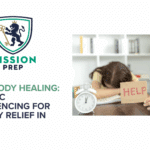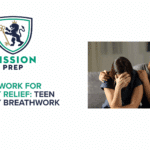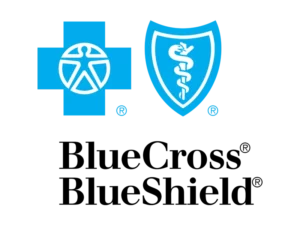Panic Attacks in Teens: Symptoms, Causes, and Inpatient Treatment

Panic attacks can feel debilitating, like everything is spinning out of control. If you’re dealing with teen panic disorder or a parent watching your child struggle, it’s completely normal to feel unsure of what to do next.
Believe it or not, panic disorder in teens is more common than most people realize, but it often requires more than just a quick fix.
That’s where specialized therapy for panic attacks in teens can really make a difference!
Programs like our teen residential anxiety program provide a safe and supportive environment, helping teens find relief and develop lasting skills to manage panic attacks. With the right tools and a caring team, it’s absolutely possible to regain control and start feeling like yourself again.
Stick around to learn more about how we can help you or your teen on this journey.

What is Teen Panic Disorder?
So, what is panic disorder in youth? Panic attacks in teens are defined by recurring and unexpected panic attacks, which impair how a teen lives their daily life. While panic attacks can happen on their own and only occasionally, panic disorder in youth involves more frequent and intense episodes that can hit unexpectedly.
Imagine suddenly feeling your heart racing, your breath quickening, and an overwhelming sense that something terrible is happening.
For teens, these repeated experiences can significantly disrupt daily activities, such as concentrating in class, completing schoolwork, or even just hanging out with friends.
Unlike adults, who might have a stronger ability to cope, teens are still developing, making it even more dire to address these challenges early on. Education about teenage panic disorder is key, empowering both teens and parents to recognize the symptoms and seek the right care to manage and move beyond the grasp of this disorder.
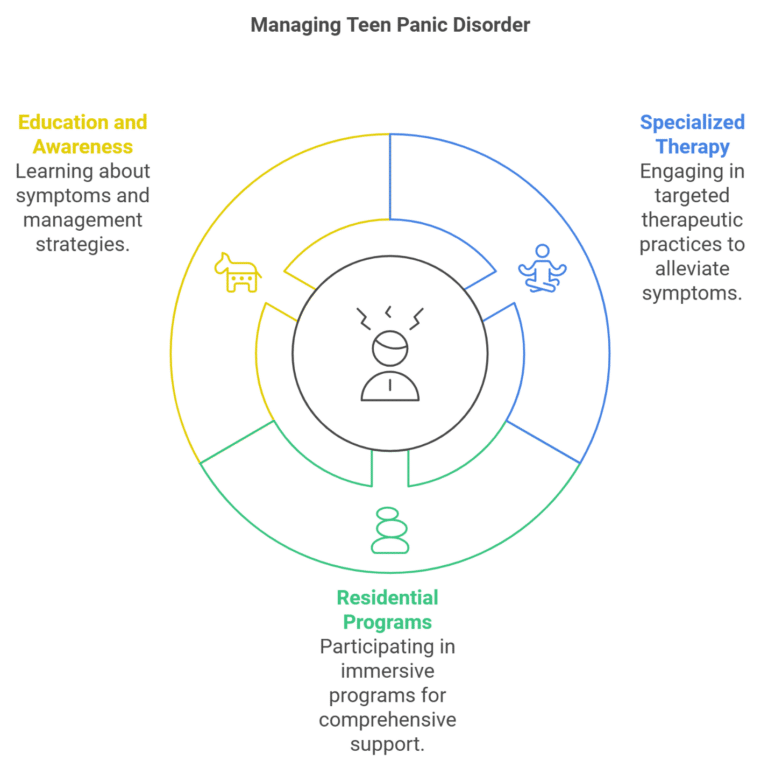

Signs and Symptoms of Panic Attacks in Teens
Understanding the signs of panic disorder in teens is crucial for early intervention and support. These experiences can appear through a variety of physical and emotional symptoms, hurting day-to-day life and well-being.
Physically, teen panic attack symptoms may look like:
- Racing heart
- Shortness of breath
- Sweating
- Trembling or shaking
- Nausea or stomach pain
- Dizziness or lightheadedness
- Chills or hot flashes
Panic attacks aren’t always physical. Emotionally, teenage panic disorder symptoms may appear as:
- Intense fear or anxiety
- Fear of losing control or “going crazy”
- Feeling detached from reality or oneself
- An overwhelming sense of doom or dread
These symptoms can vary widely and often make it challenging for teens to concentrate on schoolwork, enjoy hanging out with friends, or maintain their usual level of performance in school. Recognizing these signs early can pave the way for effective care and support.
How to Recognize Panic Disorder in Teens
Being able to spot panic disorder in youth is incredibly important for giving them the support they need.
When teens deal with recurring panic attacks, they often start avoiding places where those attacks happened before. This can really interfere with their lives, affecting everything from school to friendships.
Some might skip school to dodge the anxiety that comes with crowded places or stressful situations, leading to missed classes and slipping grades. Social lives may become strained, too, as they choose to stay home instead of facing tough situations.
Family dynamics can also become damaged when constant worry and fear overshadow everyday life. By catching these teenage panic disorder signs early, parents and caregivers can step in with understanding and kindness, setting the stage for effective help and support. Tackling these challenges directly leads to better outcomes and helps teens tackle life’s ups and downs with confidence.
Causes and Risk Factors of Panic Disorder in Teens
Understanding the causes of panic disorder in teens can make it easier to see why certain people might experience panic attacks while others don’t.
Like many mental health conditions, panic disorder is often influenced by a mix of genetic and environmental factors.
For example, if someone in your family has struggled with anxiety or panic attacks, you might have a higher chance of experiencing them, too. Family history is one of the main panic disorder risk factors in youth, along with experiences like trauma or high-stress environments.
Going through a difficult or scary event, like an accident or significant loss, can also contribute to panic symptoms.
Another important factor is that teens are in a unique stage of brain development, which can sometimes make emotions feel more intense and harder to manage. Anxiety and fear responses can be heightened in adolescence, which is why stress can feel overwhelming or even unmanageable.
It’s not your fault if panic attacks happen—they’re the result of a combination of influences outside your control. Understanding what’s behind these attacks can be the first step toward getting the right help.
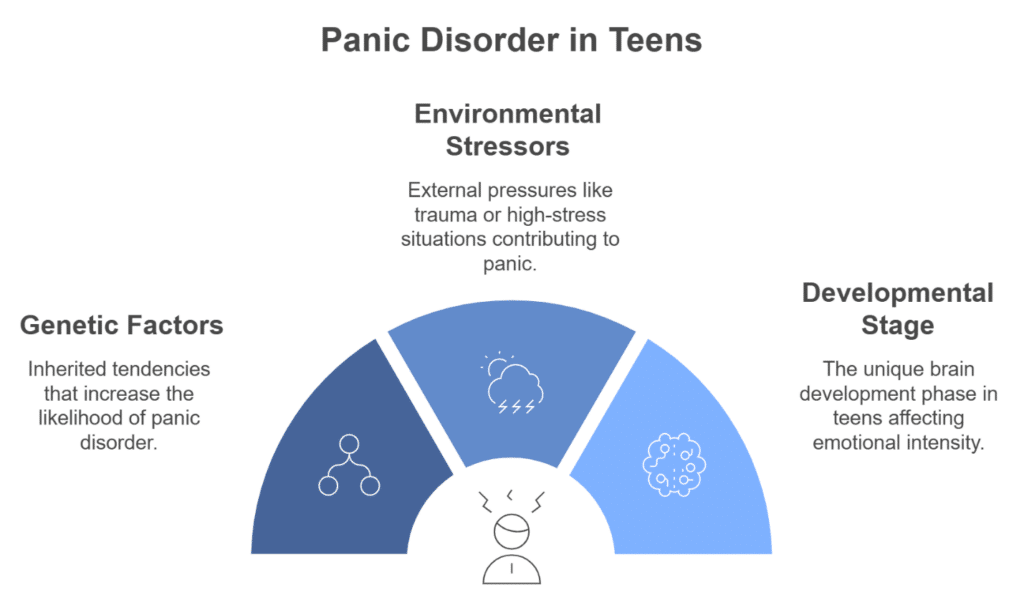
Inpatient and Residential Treatment for Teen Panic Disorder
When panic attacks make it hard to get through the day, sometimes regular therapy isn’t enough. This is where inpatient treatment for teenage anxiety and residential treatment for teen panic disorder can be great options.
These programs are designed with teens in mind, offering a structured and safe environment where your main focus is feeling better without the stress of daily life.
In youth anxiety residential programs, there’s support around the clock—from compassionate therapists and counselors to other teens who also struggle with their mental health.
These programs typically include a combination of individual therapy, group therapy, and skills-building sessions. Individual therapy helps you get to the root of your anxiety, while group therapy allows you to share experiences and gain strength from knowing you’re not alone.
In skills-building sessions, you’ll learn practical strategies for managing panic attacks, like breathing exercises and ways to calm your mind in stressful situations. Being in a safe, supportive space with others who are also working through similar issues can make all the difference.
Cognitive Behavioral Therapy (CBT) for Teen Panic Disorder
Teen CBT for panic disorder is one of the most research backed ways to help teens manage anxiety and panic attacks.
The idea behind cognitive behavioral therapy for teenage anxiety is simple: it helps you understand how your thoughts and feelings are connected, and how changing negative thought patterns can help reduce anxiety.
For example, if you constantly worry that something terrible will happen, CBT helps you challenge those thoughts and replace them with more balanced, realistic ones.
What makes CBT work so well for teens is that it’s interactive and often involves activities that keep you engaged. You won’t just sit and talk for hours; instead, you’ll practice real-world techniques that help you cope with anxiety in the moment.
It might include things like journaling, role-playing situations, or using apps that guide you through mindfulness exercises. CBT is all about helping you identify and manage the thoughts that lead to panic attacks, so you can regain control and feel more confident.
Medication for Panic Disorder in Teens
For some teens, medications for teenage panic disorder can help make panic attacks more manageable. These medications don’t “cure” panic disorder, but they can help ease the physical and emotional symptoms, so you’re better able to work through your anxiety.
The most common types of medication prescribed for teen panic attacks are:
- SSRIs (selective serotonin reuptake inhibitors): These help balance the chemicals in your brain that affect mood
- Beta-blockers: Medications that can reduce the physical symptoms like a racing heart or shaky hands that often come with panic attacks
When it comes to medication for youth panic attacks, it’s important to know that any plan is personalized to fit each teen’s needs.
In residential settings, medication is carefully monitored, and doctors make sure it’s the right fit for you. The goal isn’t just to put you on medication and hope it works, but to find a treatment plan that helps you feel better while also giving you the tools to manage anxiety long-term. And remember, medication is just one part of the puzzle—therapies like CBT also play a crucial role in your healing journey.
Exposure Therapy for Panic Attacks in Teens
Exposure therapy for teenage anxiety is all about gradually helping teens face their panic triggers in a safe and controlled environment. The goal is to reduce the fear and anxiety these triggers cause by slowly and steadily exposing you to them, rather than avoiding them altogether. It might sound counter-productive at first, but the process is guided by trained professionals who know exactly how to help you manage each step.
In exposure therapy for panic attacks in youth, you’ll start with less intense situations and work your way up as you gain confidence.
For example, if crowds make you anxious, you might begin with small, manageable exposures like standing in a quiet room with a few people. Over time, you’ll build resilience and learn coping strategies to face bigger triggers, like attending a social event.
In residential settings, exposure therapy is closely monitored to ensure you’re supported throughout the process, helping you regain control over your anxiety one step at a time.
Group Therapy and Peer Support for Teens
Teen group therapy for panic disorders are a powerful way for teens to connect with others who are going through similar struggles. Sometimes it can feel like you’re the only one dealing with panic attacks, but group therapy shows you that you’re not alone.
In group sessions, you’ll hear other teens share their experiences, which can help reduce feelings of loneliness and make you feel more understood.
Peer support for teenage anxiety is incredibly valuable in residential programs because it encourages a sense of community. Teens are able to support each other, offer advice, and celebrate progress together. When you’re surrounded by others who are also learning to manage their anxiety, it creates a bond that helps you feel less isolated and more motivated to work through your challenges.
Family Involvement in Teen Panic Disorder Treatment
Another effective approach used is family therapy for teen anxiety. It’s important to remember that the whole family plays a role in the recovery process. Family support in teenage panic disorder treatment can make a huge difference in how a teen manages their anxiety at home.
Family therapy helps parents and siblings understand what panic disorder is and how they can support their loved one through tough times. It’s not about blaming anyone; it’s about building a stronger support system and learning how to help teens manage anxiety more effectively.
In residential treatment, family involvement is a key part of the process. Many programs offer family therapy sessions to ensure everyone is on the same page and working together to create a stable, supportive environment for the teen. When families understand what’s happening and know how to provide the right kind of support, teens are more likely to feel safe and encouraged, both during treatment and once they return home. This kind of teamwork can make all the difference in the long-term success of the treatment.
How to Support a Teen During a Panic Attack
Supporting a teenager during a panic attack can be challenging, but with the right approach, you can make a significant difference.

Stay Calm
The first key is to remain calm yourself. When you’re composed, you reassure the teen that the situation is under control and help them to feel more secure. It’s crucial to remind them that they are safe and that the feelings they are experiencing will pass.
Grounding Techniques:
Using grounding techniques is another effective strategy for panic disorder treatment for teens. Encourage them to breathe slowly and deeply, counting each breath or focusing on tactile sensations, like touching a textured object or feeling their feet on the ground. These techniques can help them anchor their mind and manage the overwhelming sensations they’re experiencing.
Residential Care:
Residential treatment for teenage anxiety offers invaluable support, providing teens with access to professional help at any time of day or night. This ensures they receive the exact type of guidance they need during a panic attack. Knowing that experts are available to offer specialized assistance can be immensely comforting for both teens and their families.
By calmly guiding them through moments of panic, using supportive techniques, and considering professional care options, you can help your teen develop the resilience and tools needed to manage their panic disorder more effectively.
Diagnosing Panic Disorder in Teens
Figuring out whether a teen has teenage panic disorder diagnosis can be tough because the signs are sometimes easy to miss or misunderstand.
But, if a teen is experiencing:
- frequent panic attacks
- avoiding activities they used to enjoy
- showing signs of depression, it might be time to talk to a professional.
These symptoms could indicate that they’re struggling with panic disorder, which is more common in teens than you might think.
The earlier panic attacks are recognized and treated, the better the chances for recovery. Diagnosing panic attacks in youth early on means that teens can get the specialized treatment they need before the anxiety starts to take over their daily life.
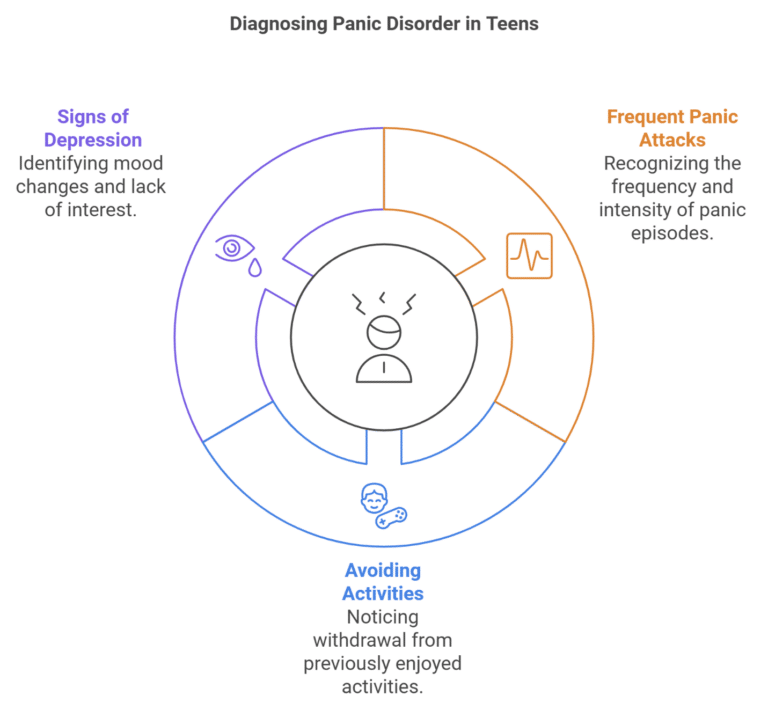

Managing Panic Disorder: Long-term Recovery for Teens
The good news is that living with panic disorder as a teen doesn’t have to be forever. With the right treatment and ongoing support, recovery is absolutely possible.
After completing inpatient or residential treatment, many teens find relief from their panic attacks, but recovery doesn’t end there. Long-term management is all about maintaining progress and preventing future setbacks.
Long-term management of panic disorder in youth involves continued therapy and self-care practices like relaxation exercises, mindfulness, and regular physical activity. It also includes regular follow-ups with a mental health professional to ensure everything is going smoothly.
Staying connected with support networks, whether it’s family, friends, or a therapist, helps teens continue to build the skills they need to manage anxiety. With time, patience, and the right tools, teens can regain control of their lives and feel confident in handling future challenges.
If you feel your teen is struggling with panic attacks and could benefit from professional support, don’t hesitate to reach out to us. We are available 24/7, ready to provide the guidance and care your teen needs to thrive. Remember, seeking help is a strong step towards recovery, and with the right support, your teen can navigate through these challenges and embrace a brighter future.

